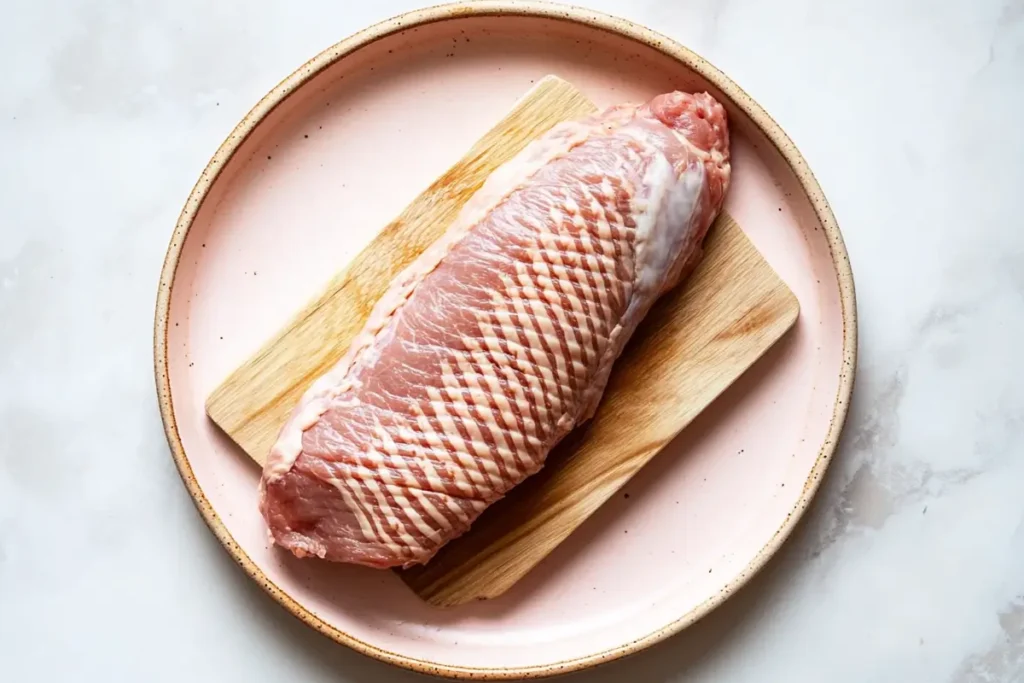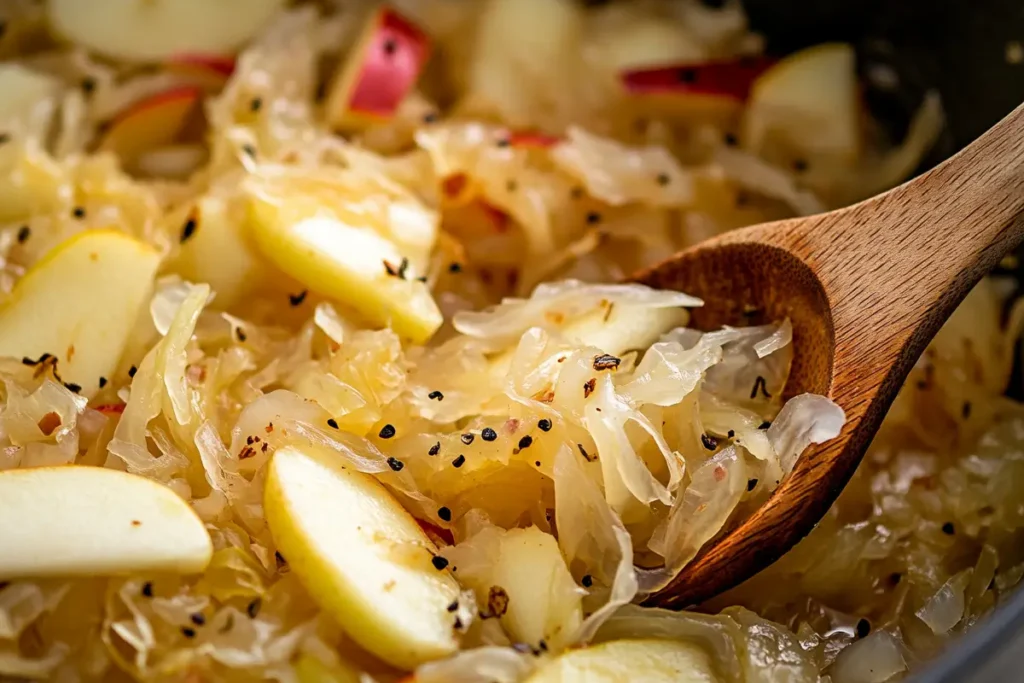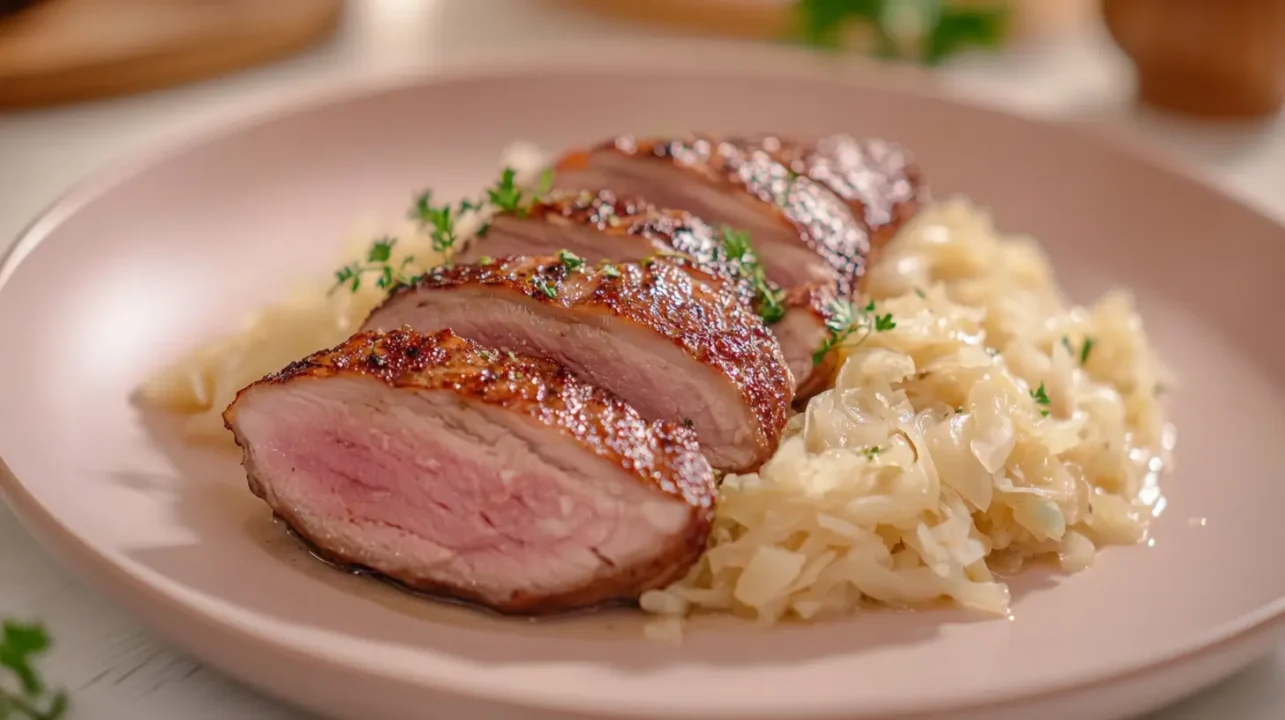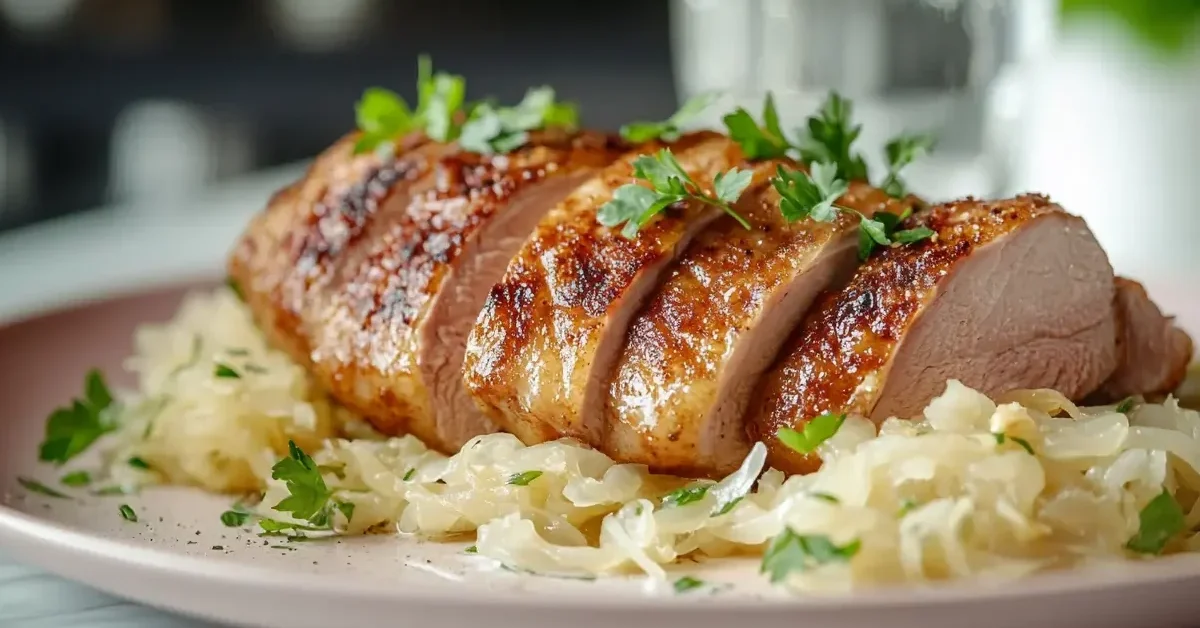Duck Breast with Sauerkraut was a staple at my grandfather’s Sunday dinners. He wasn’t a man of many words, but when he was in the kitchen, he didn’t need them. His hands, rough from years of hard work, moved with quiet precision as he prepared one of his favorite meals—crispy pan-seared duck breast with warm, tangy sauerkraut.
I remember watching him carefully score the skin, explaining in his deep, steady voice how it helped the fat render perfectly. “You don’t rush a good duck breast,” he would say, flipping it at just the right moment to reveal that golden, crackling crust. And the sauerkraut? He had a secret—always letting it simmer with a touch of apple and caraway to balance the tanginess.
As a kid, I didn’t think much of it. I loved the crispy skin, but sauerkraut? That was just something I pushed to the side of my plate. It wasn’t until years later—when I found myself craving the flavors of those Sunday dinners—that I finally understood. That simple, rustic meal wasn’t just food; it was comfort, tradition, and a lesson in patience all wrapped into one.
Now, I make this dish the way he did—simple, foolproof, and packed with flavor. And today, I’m going to show you exactly how to do it, too. Whether you’re new to cooking duck or just looking for a way to bring something special to the table, this recipe will guide you through it step by step.
But first, let’s talk about why duck and sauerkraut are a match made in heaven—and the little tricks that make all the difference.
Table of Contents
Why Duck & Sauerkraut are the Perfect Pair

Duck Breast with Sauerkraut is a timeless pairing that has been enjoyed for generations. Ever wonder why these two ingredients work so well together? It’s not just a random combination—it’s a balance of flavors that has stood the test of time. The richness of duck meat, with its crispy, golden-brown skin, needs something to balance it out. That’s where sauerkraut comes in. The bright acidity of fermented cabbage cuts through the fattiness of the duck, creating a perfect contrast of flavors.
But there’s more to this pairing than just taste. Duck and sauerkraut have deep roots in European cuisine, and understanding their history, flavor chemistry, and health benefits will help you appreciate this dish even more.
The History Behind Duck & Sauerkraut
This dish has strong ties to Central and Eastern Europe, where both duck and fermented cabbage have been staples for centuries. In countries like Germany, Poland, and Austria, duck is often served during festive occasions, especially around Christmas and New Year’s. Meanwhile, sauerkraut—fermented cabbage packed with probiotics—was essential for preserving food through long, cold winters.
In traditional German and Alsatian cooking, duck is often slow-roasted and served with sauerkraut that has been simmered with apples, caraway seeds, and white wine for extra depth. In Hungarian and Polish kitchens, you’ll find variations where sauerkraut is cooked with smoked meats or onions to enhance its savory-sour balance.
Even today, this classic combination continues to be a favorite across Europe. And now, you’re about to bring that tradition into your own kitchen!
The Science of Flavor: Why Duck & Sauerkraut Work So Well
Cooking is all about balancing flavors, and Duck Breast with Sauerkraut are a perfect example of that. Here’s why the combination works:
✔ Richness vs. Acidity: Duck is a fatty meat, while sauerkraut is sour and bright. The acidity cuts through the fat, making every bite feel lighter and more flavorful.
✔ Umami Boost: Both duck and fermented cabbage contain natural umami compounds, giving the dish a deep, savory taste.
✔ Texture Contrast: The crispy skin of the duck plays beautifully against the soft, tangy sauerkraut, adding another layer of interest to the dish.
To get the most out of these flavors, it’s important to cook the duck properly (so it stays crispy and juicy) and prepare the sauerkraut the right way (so it enhances the dish rather than overpowering it).
Health Benefits of Duck & Sauerkraut
Beyond taste, this dish also has some surprising health benefits:
🥩 Duck Breast: A great source of high-quality protein, iron, and B vitamins—essential for energy production and overall health. Plus, duck fat contains healthy monounsaturated fats, similar to olive oil.
🥬 Sauerkraut: As a fermented food, sauerkraut is loaded with probiotics, which support gut health, digestion, and even the immune system. It’s also rich in fiber, vitamin C, and antioxidants.
When you put these two ingredients together, you get a dish that’s nutritious, satisfying, and gut-friendly.
Now that we understand why this dish works so well, let’s talk about how to prepare everything for cooking—including the best ingredients, tools, and techniques to ensure a restaurant-quality meal at home.
Preparing for the Perfect Duck Breast with Sauerkraut

Before we dive into cooking, let’s make sure we have everything ready. Cooking duck breast isn’t difficult, but a few small details can make or break the final result. From selecting the right ingredients to using the best tools, this section will set you up for success.
Choosing the Best Ingredients
The quality of your ingredients plays a huge role in how this dish turns out. Here’s what to look for:
Duck Breast:
✔ Fresh vs. Frozen: Fresh duck breast is ideal, but if using frozen, ensure it’s fully thawed in the fridge for 24 hours before cooking.
✔ Farmed vs. Wild: Farmed duck has a richer fat content, which helps create that perfect crispy skin. Wild duck is leaner and may require a bit of extra care when cooking.
Sauerkraut:
✔ Store-Bought vs. Homemade: If you’re using store-bought sauerkraut, look for a brand that uses only cabbage, salt, and water—avoid additives and vinegar-based options.
✔ Mild vs. Tangy: Some sauerkraut is fermented longer, making it more sour. If you prefer a balanced flavor, a quick rinse under cold water can mellow the acidity.
✔ Flavor Enhancements: For a deeper taste, consider cooking your sauerkraut with a touch of apple, caraway seeds, or a onions.
Essential Tools & Equipment
Having the right tools makes the cooking process much smoother. Here’s what you’ll need:
✔ Sharp Knife – To score the duck breast properly for even fat rendering.
✔ Cast-Iron or Stainless Steel Pan – Helps achieve the perfect crispy skin.
✔ Meat Thermometer – Ensures precise cooking (medium-rare is around 130–135°F).
✔ Tongs & Spatula – For flipping and handling the duck without piercing it.
✔ Small Pot – To warm up and enhance the sauerkraut flavor before serving.
💡 Tip: If you don’t have a cast-iron pan, a heavy-bottomed stainless steel pan will also work, but avoid nonstick pans as they won’t allow proper browning.
How to Prep Like a Pro
A little preparation goes a long way in making sure your duck breast turns out crispy and flavorful.
Step 1: Score the Duck Skin
Using a sharp knife, make shallow cuts in a crisscross pattern across the duck skin, being careful not to cut into the meat. This helps the fat render evenly and prevents the skin from curling while cooking.
Step 2: Dry & Season the Duck
Pat the duck breast dry with a paper towel—moisture is the enemy of crispiness! Then, season both sides with salt and black pepper. That’s it! Duck is naturally rich in flavor, so simple seasoning works best.
Step 3: Prep the Sauerkraut
If you prefer a milder flavor, give the sauerkraut a quick rinse under cold water and drain well. For a warm, flavorful touch, sauté it with a bit of butter, apples, and caraway seeds before serving.
Common Mistakes to Avoid
❌ Not Drying the Duck Skin Properly → Any moisture left on the skin will prevent it from crisping up.
❌ Overcrowding the Pan → If cooking multiple duck breasts, make sure there’s space between them to allow for even browning.
❌ Skipping the Resting Time → Letting the duck rest for 5 minutes after cooking helps retain its juices and ensures a tender bite.
Now that we’ve got everything ready, it’s time for the fun part—cooking the duck breast to crispy perfection and pairing it with sauerkraut! Let’s get started.
Step-by-Step Guide to Cooking Duck Breast with Sauerkraut

Now that everything is prepped, it’s time to bring this dish to life. Cooking duck breast may sound intimidating, but if you follow these steps carefully, you’ll get crispy skin, juicy meat, and a beautifully balanced pairing with sauerkraut.
Step 1: Preparing the Duck Breast
✔ Score the Skin: Using a sharp knife, carefully score the duck skin in a crisscross pattern, making sure not to cut into the meat. This helps render the fat and crisp up the skin.
✔ Season Generously: Pat the duck breast dry and sprinkle salt and black pepper on both sides. Let it sit at room temperature for about 15 minutes—this helps it cook evenly.
💡 Did You Know? The drier the skin, the crispier it will get, so pat it dry with a paper towel before cooking.
Step 2: Cooking the Duck Breast to Perfection
✔ Start with a Cold Pan: Place the duck breast skin-side down in a cold, dry pan (no oil needed—duck has plenty of fat). Turn the heat to medium-low and let the fat slowly render.
✔ Let it Cook Slowly: Cook for 6-8 minutes, tilting the pan occasionally to spoon out excess fat. The skin should turn golden brown and crispy.
✔ Flip and Finish Cooking: Once the skin is crispy, flip the duck breast and cook for 3-5 minutes on the other side, depending on your desired doneness.
⏳ Internal Temperature Guide:
- Medium-Rare: 130–135°F (recommended)
- Medium: 140–145°F
- Well-Done: 155°F+
✔ Rest the Meat: Remove the duck breast from the pan and let it rest on a cutting board for 5-10 minutes before slicing. This keeps the juices inside for a tender bite.
💡 Chef’s Secret: If you want a deeper flavor, add garlic, thyme, or rosemary to the pan while the duck is finishing.
Step 3: Preparing the Sauerkraut
✔ Sauté for Extra Flavor: While the duck is resting, heat a small pan over medium heat. Add 1 tablespoon of butter and a handful of thinly sliced onions for extra sweetness.
✔ Warm the Sauerkraut: Stir in the sauerkraut and let it cook for 3-5 minutes until heated through. If you prefer a milder taste, add a splash of apple juice or chicken broth.
✔ Season to Taste: Sprinkle in a pinch of caraway seeds and black pepper for an extra layer of flavor.
💡 Pro Tip: For a hint of sweetness, stir in thinly sliced apples while warming the sauerkraut.
Step 4: Plating & Serving
✔ Slice the Duck Breast: Using a sharp knife, slice the duck breast against the grain into thin pieces.
✔ Arrange on a Plate: Spoon the warm sauerkraut onto a plate and place the sliced duck breast on top.
✔ Drizzle with Duck Fat: For extra richness, drizzle a spoonful of the rendered duck fat over the dish before serving.
Serving Ideas: Pair this dish with mashed potatoes, roasted root vegetables, or a side of crusty bread to soak up the flavors.
Now that you’ve mastered this classic pairing, let’s talk about additional tips, variations, and the best ways to store leftovers!
Additional Tips, Pairings, and Storage Guide
Now that you’ve mastered cooking duck breast with sauerkraut, let’s take it to the next level! Whether you’re looking for the perfect side dish, the best way to store leftovers, or a fun twist on presentation, these tips will help you get the most out of this delicious dish.
Perfect Pairings & Side Dishes
While duck breast with sauerkraut is a fantastic dish on its own, the right sides and drinks can elevate it even further.
✔ Classic Pairing: Serve with buttery mashed potatoes or crispy roasted potatoes—they soak up the duck’s rich flavors beautifully.
✔ Light & Refreshing: A simple arugula salad with a lemon vinaigrette adds a fresh contrast to the richness of the duck.
✔ Hearty & Rustic: Try pairing it with a warm lentil salad or braised red cabbage for a more traditional European meal.
✔ Wine Pairing: A dry Riesling or Pinot Noir complements both the duck’s richness and the sauerkraut’s acidity.
💡 Game Changer: If you’re hosting, serve the dish with a side of honey-glazed carrots for a hint of natural sweetness.
How to Store & Reheat Leftovers
Got leftovers? No problem! Proper storage and reheating will keep your duck breast and sauerkraut tasting just as delicious the next day.
Storing Cooked Duck & Sauerkraut
✔ Refrigerate: Store in an airtight container in the fridge for up to 3 days. Keep the duck and sauerkraut separate to maintain texture.
✔ Freeze for Longer Storage: Wrap the sliced duck breast in plastic wrap and place it in a freezer-safe bag for up to 2 months. Store sauerkraut in a separate airtight container.
Reheating Without Losing Flavor
✔ Oven (Best Method): Preheat to 350°F (175°C), place the duck on a baking sheet, and warm for 10 minutes to re-crisp the skin. Heat sauerkraut in a small pan over medium heat.
✔ Stovetop: Reheat duck in a dry skillet over medium heat for 2-3 minutes per side.
✔ Microwave (Not Recommended for Duck): If using a microwave, cover the duck with a damp paper towel and heat in 15-second intervals to prevent drying out.
💡 Top Trick: Always let duck come to room temperature for 10 minutes before reheating—this prevents it from becoming tough.
Creative Serving Ideas
Want to try something different? Here are a few fun ways to serve duck breast with sauerkraut beyond the traditional plate.
✔ Duck & Sauerkraut Sandwich: Thinly slice the duck breast and layer it with warm sauerkraut on toasted rye bread with a touch of Dijon mustard.
✔ Duck Tacos: Serve the sliced duck in warm tortillas with a bit of sauerkraut and a drizzle of honey-mustard sauce.
✔ Duck & Sauerkraut Flatbread: Spread a thin layer of crème fraîche over flatbread, top with sliced duck and sauerkraut, and bake at 375°F (190°C) for 10 minutes.
✔ Low-Carb Option: Serve over a bed of cauliflower mash or roasted Brussels sprouts instead of potatoes.
💡 Bonus Tip: If you love bold flavors, try adding a spoonful of whole-grain mustard or a dollop of cranberry sauce when serving!
Now that you know how to store, reheat, and even reinvent your dish, let’s move on to frequently asked questions and a printable recipe card to make things even easier.
Frequently Asked Questions
Q1: How do I get the crispiest duck skin?
The key to crispy duck skin is starting with a dry surface. Pat the duck breast dry with paper towels before cooking. Also, score the skin in a crisscross pattern to help the fat render out evenly. Start cooking in a cold, dry pan over medium-low heat to allow the fat to slowly render, creating that golden, crispy crust.
Q2: Can I use chicken breast instead of duck?
While chicken breast is a great alternative, it won’t have the same rich flavor or crispy skin that duck provides. If using chicken, you may want to cook it with butter or oil to mimic the richness of duck fat.
Q3: What’s the best sauerkraut to use for this recipe?
Fermented sauerkraut without vinegar (the kind found in the refrigerated section) is best for authentic flavor. If you prefer a milder taste, rinse it lightly before cooking. You can also add apples or onions to balance the acidity.
Q4: Can I prepare this dish ahead of time?
Yes! You can cook the duck breast in advance and store it in the fridge for up to 3 days. When ready to eat, reheat it in a skillet over medium heat for 2-3 minutes per side to restore crispiness. Sauerkraut can be made ahead and reheated as well.
Q5: What are some alternative seasonings for the duck?
If you want to switch up the flavors, try:
✔ Garlic & Rosemary: Classic seasoning that enhances the richness of duck.
✔ Chinese Five-Spice: Adds a sweet and aromatic twist.
✔ Smoky Paprika & Thyme: Brings a deep, earthy flavor to the dish.
Q6: What can I serve with duck breast and sauerkraut?
Some great side dish options include:
✔ Mashed Potatoes – A creamy balance to the tangy sauerkraut.
✔ Roasted Vegetables – Carrots, Brussels sprouts, or parsnips work beautifully.
✔ Crusty Bread – Perfect for soaking up the juices and extra duck fat.
Looking for More Delicious Recipes?
If you love hearty meals, check out our Main Dishes collection—perfect for family dinners or special occasions. Or, if you’re craving something sweet, browse our Snacks, Desserts & Bites section for tasty treats. There’s always something new and exciting to cook!
Print
How to Cook Duck Breast with Sauerkraut
- Total Time: 35 minutes
- Yield: 2 servings 1x
Description
A step-by-step guide to making crispy duck breast paired with tangy sauerkraut for a flavorful, restaurant-quality meal at home.
Ingredients
For the Duck Breast:
- 2 duck breasts
- Salt and black pepper, to taste
For the Sauerkraut:
- 1 cup sauerkraut
- 1 tbsp butter
- ½ apple, thinly sliced (optional)
- ½ small onion, sliced
- ½ tsp caraway seed
Instructions
- Score the duck skin in a crisscross pattern, being careful not to cut into the meat.
- Season both sides with salt and black pepper, then let rest at room temperature for 15 minutes.
- Place the duck skin-side down in a cold, dry pan. Turn heat to medium-low and let the fat slowly render for 6-8 minutes.
- Flip and cook the other side for 3-5 minutes, depending on preferred doneness. Use a meat thermometer (130°F for medium-rare).
- Rest the duck breast for 5-10 minutes before slicing.
- Prepare the sauerkraut: In a small pan, melt butter over medium heat. Add onions, apples (if using), and caraway seeds. Cook for 2 minutes.
- Stir in the sauerkraut and cook for another 3-5 minutes until warm.
- Plate and serve by slicing the duck and layering it over the sauerkraut.
Notes
- Duck breast is best cooked medium-rare to stay tender.
- For extra crispy skin, press the duck down with a spatula while cooking.
- If you prefer a milder sauerkraut, rinse it lightly before cooking.
- Prep Time: 15 minutes
- Cook Time: 20 minutes
- Cuisine: European
Nutrition
- Serving Size: ~200g per serving
- Calories: ~350 per serving
- Fat: ~22g
- Carbohydrates: ~10g
- Protein: ~32g
- Cholesterol: ~85mg
Tried this recipe? Snap a photo and tag me on Instagram @RecipesFriday—I love seeing your creations!

